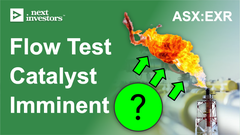EXR reveals hydrogen plans at International New Energy Summit
Elixir Energy (ASX:EXR) has outlined its plans for a hydrogen project at its massive landholding on the Mongolia-China border — a move that complements its coal seam gas operations.
After first announcing its hydrogen plans back in April, EXR Managing Director Neil Young spoke at the International New Energy Summit 2021 overnight, revealing its hydrogen ambitions.
A recording of Neil’s presentation at the summit, co-organised by the Business Council of Mongolia, can be found here (at 4:19:50):
In his presentation, Neil explains EXR’s plans in expanding the scope of its operations on its gigantic production sharing contract in Mongolia’s South Gobi region.
While it continues to progress its coal bed methane (or ‘coal seam gas’ as it’s known in Australia) exploration along the Mongolia-China border, EXR is also investigating hydrogen opportunities.
This is a region that is exceptional in its combination of massive potential gas and renewable energy resources (wind and solar) that are needed for hydrogen production, it has minimal competing land uses, and is located right in the heart of Asia.
We added EXR to the Wise-Owl portfolio in June 2020 at 3.6¢ and watched as Neil and his team executed on what he said they would, with the company hitting milestone after milestone.
That’s why we like to hear of his enthusiasm around the hydrogen potential of EXR’s gigantic landholding in Mongolia, beyond its demonstrated gas potential. The move diversifies the company's opportunities and it is highly complementary to its existing natural gas related assets and experience in Mongolia.
We already know that the company’s massive 30,000 sq. km exploration licence is highly prospective for coal seam gas — it has completed multiple successful drilling programs, unlocked new sub-basins, doubled the size of its prospective resource, and made a coal seam gas discovery made in the project area.
While EXR has continued to expand the known sub-basins across the landholding, it encountered some mechanical issues earlier this year, along with some COVID-19 related delays, that were not well received by the market.
But EXR has still been one of our best performers — up 580% — even after pulling back to its current ~23¢ level after peaking at 45¢ earlier this year.
However, other institutional investors have also recognised the opportunity here — even at higher prices — with EXR raising $10M at 36¢ (50% above the current price) earlier this year in a share Placement to institutions. It raised a further $16.6M in a Share Purchase Plan to existing investors and had $32.8M in cash at June 30.
New extensive coal-bearing basin
In addition to its hydrogen plans, EXR continues to make solid progress with its gas exploration.
Last Friday, it announced that the latest well drilled has intersected its coal target to open up another new and potentially very extensive coal-bearing basin.
Including this latest success, each of EXR’s last six wells have now intersected their coal targets — an exceptional strike rate for any region, let alone one of the sheer size and underexplored nature of EXR’s licence.
Now with this newly discovered coal-bearing basin (Richcairn), EXR has added three new potentially productive sub-basins to its inventory in 2021.
These results that have encouraged it to accelerate its drilling program for the rest of 2021, while it continues to gather data to underpin its foreshadowed two stage production testing process.
EXR sees gas-hydrogen synergies
EXR’s core strategy of exploring for natural gas just north of the Chinese border has obvious potential synergies with evaluating hydrogen (blue and green) production related opportunities in the same location.
The company’s core assets and skill sets — including dealing with multiple levels of government, local communities and potential energy markets — are as relevant to renewable energy and hydrogen production as they are to gas exploration.
In fact, one of the reasons that we initially liked EXR’s plan to explore for coalbed methane in this part of the world, was its potential to be supportive of the emerging large scale renewables industry in the region.
The growth in renewables (and gas) has been driven by China’s crackdown on coal use and it wanting to cut carbon emissions. So EXR adding hydrogen to the mix further supports the region’s fast growing green energy sector.
Green, blue, or grey?
Hydrogen is not a primary fuel source in itself but is produced from other energy sources. It functions as an energy carrier or vector and can be used to move and store renewable electricity.
It is important to understand that not all hydrogen is the same when it comes to its green credentials.
Grey hydrogen , produced from carbon intensive fossil fuels, is the most environmentally damaging as it emits CO 2 in the process.
Blue hydrogen is created from gas fired energy (EXR has gas), and while produced using fossil fuels, CO 2 is sequestered in the process.
Green hydrogen is the gold standard and the most costly. It is created via electrolysis from renewables such as wind and solar energy (EXR is now measuring the wind and sun on their giant license in the Gobi Desert).
Given the extensive renewable energy sources southern Mongolia — and its proximity to customers — EXR is in a perfect location to produce and distribute valuable green hydrogen.
Plus, if Carbon Capture and Storage proves viable in coal seams, EXR could produce blue H2 using its coalbed methane. Plus, while water costs are just a small part of total green H2 costs, water from CBM production could be used as feedstock for green H2.
Cost advantages of EXR’s world class location
EXR’s location in the South Gobi gives it a clear advantage as this may be one of the world’s best places in which to produce green hydrogen.
The South Gobi region, which hosts EXR’s current coal seam gas operations, has world class wind and solar renewable resources and it is immediately proximate to China. It is blessed by high quality renewable resources – which in the future could be exported as electricity or as hydrogen in the longer term.
Moving hydrogen between large distances, particularly between continents, is extremely expensive — far more expensive than moving equivalent quantities of natural gas.
This means that potential sources of hydrogen immediately adjacent to energy markets will be highly favoured, for instance by the massive Chinese steel industry as a coking coal replacement.
EXR’s exploration licence is adjacent to very large potential Chinese hydrogen markets including large steel mills in China’s "Inner Mongolia" region, which produce six times the total Australian steel production.
Delivery costs will be ultra low as the product can be transported by pipeline to neighbouring China, rather than by boat. Plus, Mongolia already has a world-class renewables industry (wind and solar) and the land has very few competing uses.
General Information Only
S3 Consortium Pty Ltd (S3, ‘we’, ‘us’, ‘our’) (CAR No. 433913) is a corporate authorised representative of LeMessurier Securities Pty Ltd (AFSL No. 296877). The information contained in this article is general information and is for informational purposes only. Any advice is general advice only. Any advice contained in this article does not constitute personal advice and S3 has not taken into consideration your personal objectives, financial situation or needs. Please seek your own independent professional advice before making any financial investment decision. Those persons acting upon information contained in this article do so entirely at their own risk.
Conflicts of Interest Notice
S3 and its associated entities may hold investments in companies featured in its articles, including through being paid in the securities of the companies we provide commentary on. We disclose the securities held in relation to a particular company that we provide commentary on. Refer to our Disclosure Policy for information on our self-imposed trading blackouts, hold conditions and de-risking (sell conditions) which seek to mitigate against any potential conflicts of interest.
Publication Notice and Disclaimer
The information contained in this article is current as at the publication date. At the time of publishing, the information contained in this article is based on sources which are available in the public domain that we consider to be reliable, and our own analysis of those sources. The views of the author may not reflect the views of the AFSL holder. Any decision by you to purchase securities in the companies featured in this article should be done so after you have sought your own independent professional advice regarding this information and made your own inquiries as to the validity of any information in this article.
Any forward-looking statements contained in this article are not guarantees or predictions of future performance, and involve known and unknown risks, uncertainties and other factors, many of which are beyond our control, and which may cause actual results or performance of companies featured to differ materially from those expressed in the statements contained in this article. S3 cannot and does not give any assurance that the results or performance expressed or implied by any forward-looking statements contained in this article will actually occur and readers are cautioned not to put undue reliance on forward-looking statements.
This article may include references to our past investing performance. Past performance is not a reliable indicator of our future investing performance.






